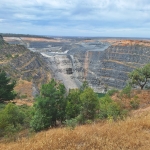MEXICO: Miners' Strike Broken in Revolutionary Cananea
In the mile-high mountains of the Sonora desert, just 25 miles south of the border between Arizona and Mexico, over two thousand miners have been locked in a bitter industrial war since mid-November. Here Grupo Mexico operates North America's oldest, and one of the world's largest copper mines -- Cananea -- in a town which has been a symbol of anti-government insurrection for almost 100
years.
On November 19, the Cananea mine was paralyzed by a strike over its owner's plans to eliminate the jobs of 700 of its 2070 blue-collar employees. Pushing the cuts in employment is a government policy of privatizing Mexican industry, downsizing its workforce in an effort to increase investment incentives. The strike in Cananea directly challenged this policies, defying Mexico's government and one of its wealthiest
financial backers.
In mid-February, government threats of armed intervention forced workers back to their jobs. In the strike's wake, one of Mexico's oldest unions -- Section 65 of the Miners and Metallurgical Workers Union of the Mexican Republic -- may have been broken, and its leaders blacklisted.
Mexican authorities ruled the strike illegal in January, threatening to withdraw the union's ability to bargain, and even its legal right to exist. The company then announced it would reopen the mine with strikebreakers, despite constitutional guarantees that struck workplaces must remain closed until the dispute is settled.
Strikers Pressured Back to Work
Local strike leaders were pressured by conservative national leaders of their union, allies of the Mexico's governing Institutional Revolutionary Party (PRI), who told them they'd already signed a
back-to-work agreement. They promised severance pay above that required by Mexican law, which calls for 20 days pay for every year of service.
When government authorities in Cananea withdrew the promise, however, miners vowed to occupy the mine itself.
On February 13, they went to their job sites in the vast pit, to hold them against possible replacements. Meanwhile, four convoys of Mexican soldiers began moving toward the town. Over 300 heavily-armed members of the state Judicial police took over the streets.
With violent confrontation in the air, local union president Manuel Romero, Cananea mayor Francisco Garcia and police and army officers, entered the mine. They walked from installation to installation, appealing to the miners to leave. Fearing the prospect of armed battle, the workers finally gave up the occupation and ended the strike.
In the days that followed, however, over 120 strike leaders were turned away at the mine gates, as they tried to report back to their old jobs. Hundreds more were permanently laid off and their jobs eliminated.
While the strike in Cananea may have ended, one its repercussions will be felt for years to come. Miners on the U.S. side of the border backed the Mexican strikers. For two months, their demonstrations and rallies throughout southern Arizona sent car caravans of food and supplies south to the mine.
And for the first time, cross-border solidarity had the official backing of the AFL-CIO itself. Previous efforts to support Mexican labor battles have drawn more limited support from U.S. unions. But a chief organizer of the activity supporting the Cananea miners was the AFL-CIO's Arizona field organizer, Jerry Acosta. While those efforts didn't succeeded in evening the steep odds faced by the strikers, they may have created a new commitment to using cross-border solidarity to win future battles.
Symbol of Insurrection
While Cananea is just a small, dusty border community of 30,000 residents, it occupies an almost mythic place in the iconography of the Mexican Revolution. Copper has been mined continuously here since the days
of the Spanish viceroys in the late 1600s.
In 1906, the mine's US owners paid a lower salary to Mexican miners than they paid to white supervisors brought down from the north. Cananea miners went on strike, demanding 5 pesos for an 8-hour day, and an end to the lower Mexican wage. After they were attacked by Arizona vigilantes, workers took up arms and were bloodily put down by then-dictator Porfirio Diaz.
In Mexican public schools, children learn of Cananea as the opening gun of what became the Mexican Revolution (which officially began in 1910), much as U.S. children learn of the 1776 battle at Lexington and Concord.
The 1906 battle not only heralded revolution to come, but was the first strike organized on both sides of the border, by the first real cross-border activists. The strike's organizers, the Flores Magon
brothers, plotted the Cananea uprising in the communities of Mexican railroad workers in East Los Angeles and St. Louis.
The Flores Magon brothers were supporters of the Industrial Workers of the World, the early U.S. industrial union of southwestern miners and farmworkers, organized by political radicals. After the strike, the brothers spent years on the run, not only from Diaz' federales, but from U.S. authorities. They were eventually sent to Leavenworth, where Ricardo Flores Magon died.
For years after the 1906 conflict, the Cananea mine belonged to the US-based Anaconda Copper Company. In 1971 the mine was nationalized. Two decades later, after the Mexican government began adopting economic reforms bent on attracting investment, Cananea was again sold to a private company. It's new owner, Grupo Mexico, is one of the country's largest industrial corporations, and its main shareholder, Jorge Larrea, heads one of the country's wealthiest families.
Larrea's industrial empire grew rapidly through his close friendship with past-President Carlos Salinas, who signed the NAFTA treaty in 1994. Under Salinas, the Mexican government sold Larrea the Cananea and
other copper mines, as well as railroads and other heavy industrial enterprises, often at a fraction of their book value. He is presently negotiating the concession to operate the Pacific coast port of Guaymas.
Thirteen Mexican financiers became billionaires during the Salinas administration. Larrea was one of them.
The enterprises acquired by Grupo Mexico have been rocked by conflict over demands for drastic job cuts. In 1997, Larrea bought the 6,521-kilometer Pacific North railroad, in partnership with Pennsylvania-based Union Pacific. Last summer, workers throughout northern Mexico mounted a series of rolling wildcat strikes over plans to reduce its workforce of 13,000 by more than half.
Grupo Mexico's four copper mines account for over ninety percent of production in Mexico, which is one of the world's ten largest producers of the metal. When Larrea took over the Cananea mine in 1991, in partnership with the American Smelting and Refining Co., its workforce numbered over 3300. In six years, the mine workforce was reduced by 1300 jobs. Meanwhile, production increased dramatically, from 30,000 tons of ore per day in 1979 to 80,000 tons last year.
Striker Javier Canizares says that these job cuts were accomplished when the company subcontracted construction and maintenence operations. "Instead of performing those jobs with its own workers, two U.S. companies, Road Machinery and Allison Parks, have brought in hundreds of workers under temporary 28-day contracts from southern Mexico," he explained.
Subcontracting undermined the union and undercut wages. Section 65, the Cananea miners' union, has a militant reputation, and their wages have averaged among the highest of the country's industrial workers --
between $8-12 an hour.
Gabino Paez Gonzalez, a Grupo Mexico executive in Mexico City, confirmed that subcontractors now perform many operations with contract employees. Under Mexican law, workers don't achieve permanent employment
status and union rights until they have been on the job for 30 days.
The spark which provoked the recent strike was a company announcement that it would lay off 435 workers permanently, closing four mine departments.
Ecological Disaster
Miners charge closure plans will have environmental consequences. Grupo Mexico says it is shutting the smelter at Cananea, which employs 325 workers. When the company bought the mine, it agreed to install pollution-control devices at the facility. The company never bought the equipment, however, and now plans to ship the ore by train to another smelter at its nearby mine in Nacozari.
Waste water from ore processing is currently held behind a large dam. The company has announced it is terminating all 135 workers who maintain that tailings pond. According to striker Rene Enriquez Leon, mine
runoff could reach the headwaters of the Sonora River nearby, and lead to massive pollution problems in the extensive farming regions downstream. "It would be an ecological disaster," he said.
Another department which closed at the end of the strike, the town's water works, caused a further crisis for Cananea residents. The mine has been responsible for providing water to the town, along with its own mining operations, for 80 years. According to Paez, "we insisted that the city take over operations of the water system. It is their responsibility."
Cananea, however, has no money or personnel to run the system. Residents accused the company of putting untreated water into the town's water supply, and Canizares says 10 cases of hepatitis were discovered at a
local school where water was cut off to its bathrooms. A demonstration of four hundred women on March 11 took over pumping stations, stopping the supply of water to both the mine and the town, to force the company to reassume responsibility for the system. In the countryside surrounding Cananea, local farmers supporting the women halted the operation of wells on their land which are the water's original source.
A Watershed in Cross-Border Solidarity
During the strike, the unionists won support from the Cananea's mayor, who himself worked in the mine for 18 years. Popular sympathy for the miners induced the governor of Sonora and all three political parties in the state legislature, including the ruling PRI and the opposition Party of the Democratic Revolution and National Action Party, to express verbal support.
But strikers say their most important help came from copper miners and unions north of the border. Within days of walking out of the mine on November 18, they had already sent a group to Tucson to appeal for food and money. There they found Jerry Acosta.
As Arizona representative of the AFL-CIO's Department of Field Mobilization, Acosta was in a unique position to publicize their cause. He won union support by arguing that U.S. miners would be directly affected by the strike. "Because of NAFTA," he said, "U.S. corporations have moved jobs to Mexico, where they pay lower wages and aren't restricted by union contracts or environmental regulations. If the union in Cananea is broken, efforts by Mexican workers to pull wages up and enforce their rights will be set back."
Appeals from Cananea also struck a sympathetic chord because many families, divided by the border, have members working in the mines in both countries. "My cousins work in Cananea," Acosta explained.
In Mexico City, the representative of the AFL-CIO's Center for International Solidarity, Tim Beaty, tried to convince the leaders of the Mexican miners union to give more support to their own strike. But Tucson attorney Jesus Romo, who counseled the striking miners, accuses them of being more loyal to the government and the PRI than to their own striking members. "Once the strike started," Romo said, "they began to fear losing control over their own union. They couldn't stop miners from seeking support north of the border without losing their credibility, but they tried to reassign them to activity elsewhere."
Strikers charge that those who went to the U.S. seeking support were targeted for firings, and received death threats from police and company guards. In mid-January, the Judicial police broke into the homes
of two of them, Rene Enriquez and Reynaldo Palomino, terrorizing their families.
In a January press conference, another Grupo Mexico spokesperson, Jose Fernando Rodriguez Correa announced that 198 strikers had been terminated, and later threatened to lay off all Cananea workers, rehiring only 80% under new arrangements. Arizona attorney Jesus Romo, who counseled the strikers, charged that "workers gathering U.S. support were all included in the termination list."
Paez denies that the company has a blacklist, and says some workers haven't been rehired yet because there's no place for them anymore, due to the job cuts. But according to Canizares, who worked at the mine for 15 years and has not been rehired, "Jose Valderrama [the mine's director of labor relations] told me that they don't want anyone working here anymore who disagrees with their policy. They want people who are obedient, who don't defend their rights."
Gema Lopez Limon, professor at the University of Baja California in nearby Mexicali, concludes that "our government and corporations are using privatization to do away with unions entirely, as they've sought to do with the railroad workers, and now the miners here in Cananea. For unions to survive here, they will have to be much better organized, and seek even greater international support."
Acosta concluded that the stakes are higher for U.S. unions as well, as a result of the strike. "When companies can pick up and go five miles to the other side of the border, where a miner earns less in a day than his relative on this side earns in an hour, can we find the solidarity to bridge the gap?" he asked.
"If we can't find the answer, we're all going to suffer."
- 190 Natural Resources



